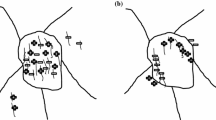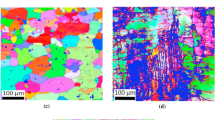Abstract
Because creep of metals and alloys is modelled on the basis of microstructural observations, it has been shown that there is a difference between the mathematical treatment of high-temperature deformation and the real material behaviour. One idea to consider is to split the applied stress into a part depending on the substructure (the internal stress which has to be reached to start dislocation motion) and a part describing the resistance to the glide motion of dislocations (the effective stress). For ferritic chromium steel these quantities have been measured by means of the stress transient dip test technique. This leads to mean values of internal and effective stresses for the whole specimen. Additionally, local stresses acting on individual dislocations are evaluated from dislocation bowing for a wide range of applied stresses. The results show that the ratio of internal to applied stress decreases with increasing applied stresses, which, on the other hand, causes a large increase of effective stresses. Dislocation bowing stresses show a similar dependence. Compared to the results of dip tests, the determination of local stresses leads to less accurate results and to a large deviation of results within small regions of one specimen. Therefore, it is only valuable for comparison purposes.
Similar content being viewed by others
References
W. Blum, Z. Metallkde 68 (1977) 484.
W. D. Nix and B. Ilschner, in “Proceedings of the 5th International Conference on the Strength of Metals and Alloys”, Vol. 3, Aachen, August 1979, edited by P. Haasen, V. Gerold and G. Kostorz (Pergamon, Oxford, 1979) p. 1503.
H. J. Frost and M. F. Ashby, in “Deformation Mechanism Maps, The Plasticity and Creep of Metals and Ceramics” (Pergamon, Oxford, 1982).
D. Caillard, Mater. Sci. Engng 81 (1986) 349.
M. Biberger and W. Blum, Scripta Metall. 23 (1989) 1419.
F. Groisböck and R. Ebner, Z. Metallkde, 82 (1991) 435.
F. Groisböck, Doctoral thesis, Leoben (1990).
S. Takeuchi and A. S. Argon, J. Mater. Sci. 11 (1976) 1542.
F. Groisböck, R. Ebner and F. Jeglitsch, in “Proceedings of the 1st International Conference on Advanced Materials and Processing”, Aachen, November 1989, edited by H. E. Exner and V. Schumacher (DGM Informationsgesellschaft mbH, Oberursel, 1990), p. 579.
J. Cadek, Mater. Sci. Engng 94 (1987) 79.
S. U. An, H. Wolf, S. Vogler and W. Blum, in “Proceedings of the 4th International Conference on Creep and Fracture of Engineering Materials and Structures”, Swansea, April 1990, edited by B. Wilshire and R. W. Evans (Institute of Metals, London, 1990), p. 81.
A. A. Solomon, Rep. Sci. Instrum. 40 (1969) 1025.
C. N. Ahlquist and W. D. Nix, Scripta Metall. 3 (1969) 679.
J. J. Urcola and C. M. Sellars, Acta Metall. 35 (1987) 2659.
K. Toma, H. Yoshinaga and S. Morozumi, Trans. Jpn Inst. Metals 17 (1976) 102.
W. Blum and E. Weckert, Mater. Sci. Engng 86 (1987) 145.
F. Groisböck and R. Danzer, Z. Metallkde, 82 (1991) 519.
F. Dobes, Acta. Metall. 28 (1980) 377.
J. Friedel, in “Dislocations” (Addison Wesley, Reading, MA, 1964), Ch. 16.
J. Friedel, in “Electron Microscopy and Strength of Crystals”, edited by G. Thomas and J. Washburn (Interscience, 1963) p. 605.
L. P. Kubin and J.-L. Martin, in “Proceedings of the 5th International Conference on the Strength of Metals and Alloys”, Vol. 3, Aachen, August 1979, edited by P. Haasen, V. Gerold and G. Kostorz (Pergamon, Oxford, 1979) p. 1639.
F. Groisböck, J. Mater. Sci. 27 (1992) 4373.
Author information
Authors and Affiliations
Rights and permissions
About this article
Cite this article
Groisböck, F., Jeglitsch, F. Internal and effective stresses in high-temperature creep evaluated from transient dip tests and dislocation bowing. J Mater Sci 27, 4365–4372 (1992). https://doi.org/10.1007/BF00541568
Received:
Accepted:
Published:
Issue Date:
DOI: https://doi.org/10.1007/BF00541568




